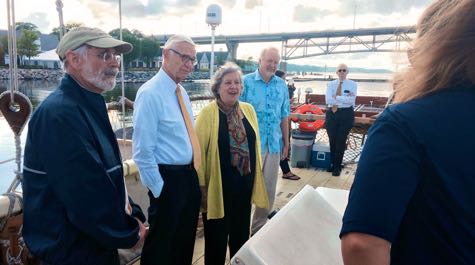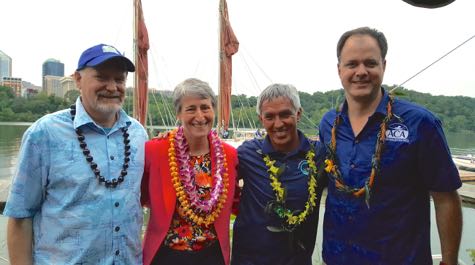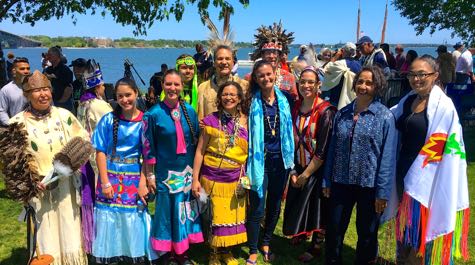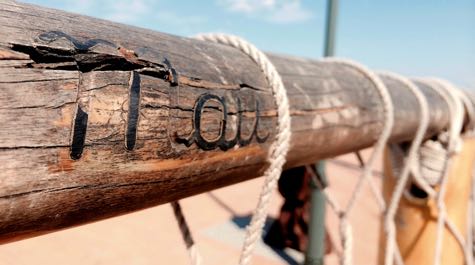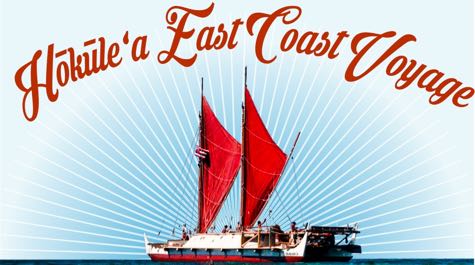VIMS helps steer visit of Polynesian sailing canoe
The recent visit to Hampton Roads by the Polynesian voyaging canoe Hokule’a was just one of myriad port calls during the vessel’s three-year, 54,000-mile circumnavigation of Earth. The story of how it came to dock in local waters is nearly as circuitous as its voyage, with just the kinds of coincidences and quirks one would expect from a true high-seas adventure.
The role of William & Mary's Virginia Institute of Marine Science in steering the 62-foot double-hulled Hokule’a toward the Chesapeake Bay began a quarter century ago, when Kirk Havens, now assistant director of VIMS’ Center for Coastal Resources Management, took part in a canoe race from Molokai to Oahu. Its sails steered even closer each time VIMS Assistant Professor Kevin Weng spied the Hokule’a at berth when leaving the dock for field research in his previous position at the University of Hawaii.
Havens, an avid canoeist, said, “I paddled the 40-mile Molokai Hoe outrigger race in 1990 and met Nainoa when he volunteered to steer our team of Virginians.”
“Nainoa” is native Hawaiian Charles Nainoa Thompson, current president of the Polynesian Voyaging Society and a master in the traditional art of navigating by stars, waves and animal behavior.
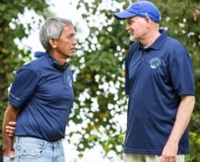 Havens says he and Thompson developed a fast friendship during that often-treacherous journey across the Kaiwi Channel. When Havens returned to Hawaii in 2011 to speak at the International Marine Debris Conference, the pair met up again.
Havens says he and Thompson developed a fast friendship during that often-treacherous journey across the Kaiwi Channel. When Havens returned to Hawaii in 2011 to speak at the International Marine Debris Conference, the pair met up again.
“Nainoa was planning Hokule’a’s worldwide voyage at the time,” said Havens, “and I was the president of the American Canoe Association. Since the Hokule’a is a Polynesian voyaging canoe, it only seemed appropriate that the ACA help with the voyage.” It didn’t hurt that Havens’ work at VIMS encompasses the same concerns for ocean sustainability that inspired the Hokule’a’s current journey.
The Hawaiian name for that journey is Mālama Honua: “to care for our Earth.” Thompson says the voyage “is a way to engage all of Island Earth — to bridge traditional and new technologies to live sustainably, while sharing, learning, creating global relationships and discovering the wonders of our planet.”
To help share this message in Hampton Roads, Havens partnered with VIMS Outreach Director Susan Maples, the Mariner’s Museum, the local Hawaiian community and other groups to arrange a series of public presentations involving Hokule’a’s crew. For VIMS, these included an After Hours lecture, a Science Under Sail cruise aboard the schooner Alliance and a public education day at the Jamestown Fishing Pier. A lead representative for the local Hawaiian community was Lisa Tam-Hoy, a W&M graduate who runs ‘Ohana Arts Studio in Newport News.
Havens was also deeply involved in planning for the Hokule’a’s welcome ceremony in Yorktown with local Native American tribes. He says the tribes’ participation helped to further highlight long-term sustainability and the wisdom of indigenous cultures.
{{youtube:medium|601OvK8I9fw, The arrival of Polynesian sailing canoe Hokule'a in Yorktown}}
Weng, who had regularly motored past the Hokule’a in its homeport of Honolulu and has friends that had crewed the boat on previous voyages, learned about the vessel’s planed visit to Chesapeake Bay from Havens in 2015. He soon realized the visit would dovetail with a course he had already begun developing — an in-depth look at food, energy and water systems in the context of islands and island life.
Weng offered the independent-study course this spring through W&M’s Commonwealth Center for Energy and the Environment (CCEE), in collaboration with Havens, fellow fisheries professor Andrew Scheld and three colleagues from the anthropology department at W&M: Bill Fisher, Jenny Kahn and Danielle Moretti-Langholtz. Two W&M undergraduates — Eileen Nakahata and Quinn Monette — undertook detailed research during the semester. The capstone was a workshop in which participating students interacted with a diverse cast of characters involved in the Hokule’a’s visit.
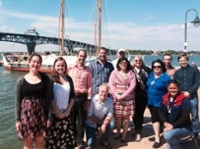 “Kirk had also submitted a proposal to CCEE,” said Weng. “We realized there was a lot of overlap between our projects, so we decided to combine them. I started helping Kirk with the Hokule’a and we pulled crewmembers into my workshop. We also invited people from Virginia Native American tribes and Tangier Island to participate in both the workshop and visit.”
“Kirk had also submitted a proposal to CCEE,” said Weng. “We realized there was a lot of overlap between our projects, so we decided to combine them. I started helping Kirk with the Hokule’a and we pulled crewmembers into my workshop. We also invited people from Virginia Native American tribes and Tangier Island to participate in both the workshop and visit.”
Weng says the workshop, held in Yorktown just yards from Hokule’a’s berth, was the culmination of a semester-long exploration of “islands” of all kinds and scales, from “the Hokule’a itself, to small islands such as Tangier, large islands like Oahu and our planet, Island Earth.”
“The definition of an island, from the perspective of food, energy, and water systems, is quite nuanced,” said Weng. “Oahu is very insular, whereas Tangier is fairly well connected to the nearby mainland.”
One thing these islands do share is a traditional culture that is under threat.
“Island communities are particularly vulnerable to climate change, globalization, and other large-scale forces,” said Weng. “The workshop gave our students an opportunity to discuss these challenges — and potential solutions — face-to-face with individuals from affected communities. It was an opportunity to enrich their community and ours.”
VIMS’ involvement in Hokule’a’s visit to Chesapeake Bay didn’t stop when the vessel left Yorktown on May 8. After stops at Tangier Island, Piscataway Park on the Potomac and Old Town Alexandria, the vessel docked at the Washington Canoe Club on May 18, where Havens joined Nainoa Thompson and his fellow crewmembers to meet with U.S. Secretary of the Interior Sally Jewell, other members of the Obama administration and several senators for further discussion of the environmental issues affecting Chesapeake Bay and the world’s oceans. Havens said that U.S. President Barack Obama may make his National Oceans Month proclamation from the deck of the Hokuleʻa later this month.
From Washington, the Hokūueʻa will sail to New York City to arrive in time for World Oceans Day on June 8. U.N. Secretary General Ban Ki-moon is expected to proclaim the importance of this global day of celebration from the deck of the Hokuleʻa as well.














